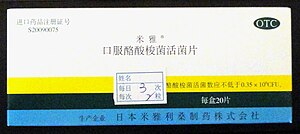クロストリジウム・ブチリカム
Clostridium butyricum/ja
クロストリジウム・ブチリカムは厳密に嫌気性内胞子を形成するグラム陽性の酪酸産生桿菌である。細胞内に蓄積したアミロペクチン様α-ポリグルカン(グラニュロース)を基質として発酵する。ヒトの病原体としての報告は少なく、日本、韓国、中国ではプロバイオティクスとして広く利用されている。C. ブチリカムは世界各地の土壌に生息し、健康な子供や成人の便から培養され、酸っぱい牛乳やチーズによく含まれる。乳製品との関連性は名前からもわかるように、butyricumのbutyr-は細菌の代謝における酪酸の関連性を反映しており、ラテン語のbutyrumとギリシャ語のβούτυρονとの関連性を表している。
| Clostridium butyricum/ja | |
|---|---|

| |
| C. ブチリカム MIYAIRI 588 錠(ミヤリサン製薬、東京、日本) | |
| Scientific classification | |
| Domain: | Bacteria |
| Phylum: | Bacillota |
| Class: | Clostridia |
| Order: | Eubacteriales |
| Family: | Lachnospiraceae |
| Genus: | Clostridium |
| Species: | butyricum
|
| Binomial name | |
| butyricum Prazmowski 1880 (Approved Lists 1980)
| |
産業上の関連性
19世紀における発酵の研究は,基礎科学だけでなく,主にワイン醸造や醸造などの特定の産業において,プロセスのより深い理解と制御によって不良ロットのリスクを低減する手段として企業から資金提供される応用科学としても関心を集めていた。そのため、ルイ・パスツールのような初期の微生物学者は、微生物の代謝と生化学の研究に資金を提供された。このような研究は嫌気性代謝の最初の理解につながり、酪酸発酵はその世界への人類の最初の窓となった。1880年、ライプチヒ大学のアダム・プラズモフスキ(Adam Prażmowski)が初めてClostridium butyricumという二命名した。
治療利用
最初のC. butyricum MIYAIRI株は、1933年に宮入親治博士によって日本の糞便から分離された。1963年、CBM 588株が長野市の土壌サンプルから分離された。CBM 588に基づく製剤は、日本ではヒト集団で安全に使用されてきた長い歴史があり、そのような製品は医薬品、「医薬部外品」、OTC(市販薬)プロバイオティクスとして様々に分類されている。ヒト集団におけるCBM 588の安全な治療使用は、重症の患者、免疫不全患者、入院患者、および妊婦におけるCBM 588の使用に関する報告を含む、様々な査読付き出版物および症例研究によって裏付けられている。
Its usefulness stems primarily from its ability to interfere with the growth of highly pathogenic Clostridium difficile by antagonizing its multiplication. It is often used in Japanese hospitals for C. difficile prophylaxis among in-patients and, particularly, during administration of certain powerful antibiotics (i.e. Levofloxacin) associated with opportunistic C. difficile infection.
CBM 588 was approved for clinical use in humans by the Japanese Ministry of Health and Welfare in 1970. The standard preparation as marketed by Miyarisan Pharmaceutical (Tokyo, Japan) consists of white, marked tablets each containing 0.35 × 106 colony forming units (CFU) of C. butyricum MIYAIRI 588 (as active agent). CBM 588 does not establish permanently in the gut, in common with other orally administered probiotic bacteria. CBM 588 for clinical use is produced by submerged anaerobic fermentation followed by centrifugation, drying, blending and packaging.
The MIYAIRI 588 strain of C. butyricum does not carry any genes encoding any toxins and virulence factors associated with Clostridium or other enteropathogens. Absence of neurotoxin production has been demonstrated by polymerase chain reaction (PCR) and Southern blot hybridisation for type E botulinum toxin gene. The absence of genes encoding botulinum neurotoxin A,B,F and genes encoding non-toxic haemagglutinin (NTNH) and genes encoding Clostridium perfringens toxins (alpha, beta, epsilon and iota) has been demonstrated by PCR assay.
This strain is deposited at the Fermentation Research Institute, Agency of Industrial Science and Technology, Japan under the strain name Clostridium butyricum MIYAIRI 588 strain, deposit number FERM BP-2789. Recent European Food Safety Authority opinions confirm the official strain nomenclature as Clostridium butyricum FERM BP-2789.